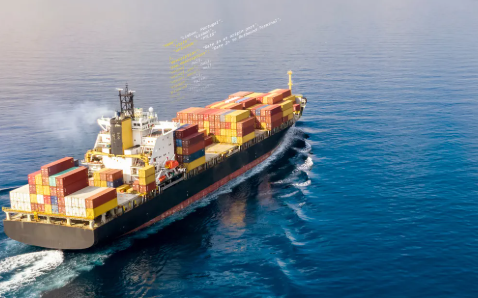Understanding Container Tracking APIs: Features and Benefits for Logistics

TL;DR
API container tracking provides logistics teams with automated, real-time updates on container movements across global carriers. With Vizion’s Container tracking API, businesses reduce demurrage and detention charges, improve shipment visibility, streamline operations, and make data-driven decisions with confidence.
Introduction: The Growing Need for API Container Tracking in Logistics
Delays at ports, missed transshipments, and manual status checks are more than just routine disruptions, they can result in high operational costs and broken customer promises. In a world of increasing shipment volumes and complexity, logistics teams need a smarter way to track container movement.
Larger ports that process 500,000 TEUs or more per year employ equipment that relies on GPS for positioning and often automates the processing of containerized cargo.
API container tracking addresses these challenges head-on. By integrating Vizion’s Container tracking API, companies gain continuous, accurate visibility into their maritime shipments. This isn’t just about data access, it’s about improving how supply chains function day to day.
Market Growth and Industry Trends
- Far East exports led the way in 2024, rising 8% over the previous year and 10% compared to 2022. While shipments to North America continued to make up the largest share, exports from the Far East to Europe and the Indian Sub-Continent & Middle East also saw impressive growth.
- Traditional EDI feeds and manual tracking are proving insufficient for high-volume shipments.
- Demand for scalable, standardized visibility tools like Container tracking API is growing rapidly among freight forwarders and logistics providers.
With more shipments crossing international borders than ever before, the logistics industry is turning to automation to address challenges around scalability, transparency, and cost control. The rise of API container tracking reflects this shift offering logistics teams a reliable way to keep up with growing complexity.
What Is an API for Container Tracking?
APIs (Application Programming Interfaces) have become essential tools in logistics. An API for container tracking acts as a secure digital bridge between data sources (like carriers and terminals) and the systems you use to manage shipments.
How API Container Tracking Works
- The Container tracking API ingests raw shipment data from ports, carriers, terminals, and customs authorities.
- It standardizes these inputs into a consistent, readable format.
- Data is automatically pushed into your internal platforms (ERP, TMS, or customer portal).
- Updates include detailed events like “container gated in,” “customs cleared,” “vessel departed,” and “container delivered.”
By turning fragmented event data into structured insights, API container tracking simplifies the work of logistics professionals who otherwise rely on emails, spreadsheets, and portal checks.
Key Use Cases in Modern Supply Chains
API container tracking supports a wide range of applications:
- Freight Forwarders: Centralize updates across multiple clients, shipments, and carriers.
- Logistics Technology Providers: Deliver live container status updates through customer-facing apps and dashboards.
- Shippers and BCOs: Monitor global shipments proactively, identify slow-moving cargo, and prevent bottlenecks.
These capabilities empower businesses to plan better, communicate faster, and operate with fewer interruptions.
Read Also: Anime Characters in Motion! ComfyUI Motion Transfer Technology Unlocks New Creative Possibilities
Core Features of API Container Tracking Solutions
A high-quality Container tracking API must go beyond just pinging a carrier database. It should provide standardized, enriched, and event-level visibility that logistics teams can trust and act on.
Real-Time Shipment Visibility
Stay informed at every stage of the journey—from port departure to final delivery. Real-time visibility means:
- Notifications when containers are discharged or gated out
- Updates on vessel arrival and departure
- Customs milestones and inspection status
This feature helps logistics teams respond to issues quickly and prevents costly delays from going unnoticed.
Automated Data Integration and Updates
Instead of chasing updates across 10 different portals, data arrives automatically via API. The Container tracking API eliminates repetitive manual work, reduces errors, and ensures decision-makers always have current information.
- Direct system-to-system integration
- Automated syncing with TMS or visibility platforms
- Near real-time delivery of container event data
Multi-Carrier and Multi-Modal Support
Global supply chains span dozens of carriers and routes. A strong API container tracking tool offers:
- Coverage across major ocean carriers
- Transshipment tracking across terminals and ports
- Support for multimodal journeys that include barge or rail
This feature ensures you have a complete view, no matter how complex the shipment.
Security and Data Quality
All data shared through Vizion’s Container tracking API is encrypted, verified, and enriched to provide:
- Standardized event naming
- Clean and reliable timestamps
- Elimination of duplicated or outdated updates
Data integrity is critical when making operational decisions based on container events.
Benefits of Implementing API Container Tracking
Beyond features, the real impact of API container tracking is seen in how it transforms your day-to-day logistics outcomes.
Reducing Demurrage and Detention Fees
Delays in collecting containers often result in demurrage (charges for staying too long at port) and detention (charges for holding on to containers too long). With timely updates from the Container tracking API, teams can:
- Coordinate truck pickups before free time expires
- Spot customs holds early
- Re-route or expedite action when delays occur
These insights prevent costs from spiraling due to missed deadlines or unanticipated dwell times.
Enhancing Operational Efficiency
By eliminating redundant tasks, API container tracking frees logistics teams to focus on proactive planning.
- No more manual spreadsheet tracking
- Reduced communication overhead
- Faster issue resolution across teams
This translates to better internal coordination, faster turnaround, and improved shipment reliability.
Improving Customer Communication and Transparency
Customers expect updates—especially when things go wrong. With real-time event feeds, you can:
- Share accurate ETAs and milestone events
- Communicate delays before they impact downstream operations
- Strengthen trust through transparency
Supporting Data-Driven Decisions
With access to enriched container event histories, you can:
- Analyze port performance
- Identify lanes with chronic delays
- Measure carrier reliability and plan accordingly
These insights help improve future planning and reduce exposure to risk-prone routes.
Vizion’s Approach to API Container Tracking
While many providers offer fragmented visibility, Vizion stands apart with standardized, scalable, and enriched tracking designed for enterprise logistics.
Real-Time Container Tracking Across Global Carriers
Vizion’s Container tracking API covers more than 99% of ocean freight shipments worldwide, delivering:
- Timestamped container events
- Transshipment tracking
- Vessel, terminal, and rail visibility in one feed
You receive structured updates at every stage, improving clarity and confidence.
Customs Clearance Automation
Avoid lengthy clearance delays by monitoring:
- Customs inspections and holds
- Release status and clearance timestamps
- Shipment progression post-clearance
By acting on real-time customs data, logistics teams prevent idle containers and avoid storage fees.
Port Performance and Activity Insights
Through port-level datasets, Vizion enables clients to:
- Benchmark dwell times
- Track congestion levels
- Choose more efficient port pairs and routes
This ensures containers spend less time waiting and more time moving.
Trade Intelligence and Historical Analytics
Using TradeView, logistics teams gain access to:
- Historical shipment trends
- Trade volume analytics by region
- Supplier activity and trade routes
These insights enhance long-term planning and provide a competitive advantage.
Addressing Common Logistics Challenges with API Container Tracking
Let’s examine how API container tracking solves recurring issues in global logistics.
Managing Complex Global Shipments
When shipments pass through multiple carriers, countries, and ports, traditional tracking falls short. Vizion’s solution:
- Consolidates all updates into a single feed
- Simplifies data access across stakeholders
- Tracks containers end-to-end, regardless of carrier
This helps logistics managers gain control over even the most fragmented movements.
Preventing Cargo Theft and Loss
With more granular visibility:
- Unexpected container movements can trigger alerts
- Missing updates indicate potential disruptions
- Teams can intervene faster before losses escalate
This added layer of awareness is key for high-value cargo and regulated goods.
Adapting to E-Commerce and Trade Growth
With smaller, more frequent shipments on the rise, real-time tracking supports:
- Faster response to customer demand
- Better performance during seasonal peaks
- Scalability without compromising control
The Container tracking API ensures that shipment growth doesn’t overwhelm your operations.
How to Choose the Right API Container Tracking Solution
Not all tracking tools offer the same value. Choosing the right partner means aligning capabilities with your goals.
Essential Evaluation Criteria
Ask these key questions:
- Does the provider offer wide global coverage?
- Are updates real-time and validated?
- Is the data structured and enriched?
- Do they offer developer support and documentation?
Vizion’s approach checks all the above—delivering data you can depend on.
Integration with Existing Systems
Your solution should enhance—not disrupt—your current tech stack. Vizion’s Container tracking API integrates with:
- ERPs
- TMS
- Customer-facing visibility platforms
This flexibility ensures fast deployment and immediate ROI.
Scalability and Support
Whether tracking 100 containers or 100,000, Vizion scales with your needs. Enterprise-grade infrastructure and responsive support teams help clients manage growth without complexity.
FAQs: API Container Tracking
Q1: What is API container tracking?
It’s the use of APIs to receive automatic updates on container milestones from carriers and ports—enabling real-time supply chain visibility.
Q2: How does the Container tracking API improve efficiency?
It eliminates manual tracking, reduces errors, and feeds real-time events into your systems for faster decision-making.
Q3: Is Vizion’s tracking limited to certain carriers?
No. Vizion covers over 95 global ocean carriers and continues to expand its network.
Q4: Can the data be used for performance analysis?
Yes. Event history helps evaluate port dwell times, carrier delays, and shipment reliability over time.
Q5: How quickly can the API be integrated?
Vizion offers comprehensive documentation and developer support to ensure smooth, fast onboarding..






